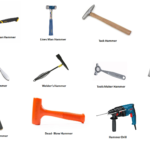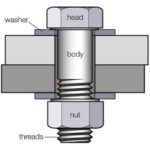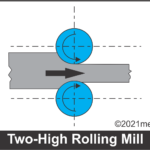Introduction
The cast iron was invented in the 5th century BC in China. It is used almost in every corner of the world. Whether it is the automotive industry, construction industry, manufacturing industry, piping industry, etc. everywhere cast iron is used. In this article, you will learn about what is cast iron, its types, application, how it is produced, etc. So let’s begin with its definition.
Definition
It is a group of iron-carbon alloys in which the carbon content ranges from 2 to 4 percent and silicon ranges from 1 to 3 percent along with small impurities like phosphorus and sulphur. If the carbon content in the iron alloys is less than 2 percent then it is known as steel.
Properties of Cast Iron
- Brittle: Cast iron is brittle except malleable cast iron. Brittle means, it breaks into small pieces when hammered.
- Low Melting Point: It has a low melting point (1127 – 1204 degree Celsius)
- Fluidity: It possesses good fluidity ( The ability to flow easily in a molten state)
- Castability: It possesses good castability. Castability is defined as the ability to be cast into new parts in the casting process.
- Machinability: It has good machinability. Machinability is defined as the ability of a metal that allows being cut (machined) easily with a good surface finish at a low cost.
- Resistance to deformation and wear resistance: It has excellent resistance to deformation i.e. it does not changes its shape when force is applied to it. It also has wear resistance which means that it opposes the damage in normal usage.
Melting Point of Cast Iron
The melting point of cast iron ranges in between 1127 to 1204 degree Celsius
What is Cast Iron Made up of ?
Cast iron is an alloy of iron and carbon in which the carbon is present in the range of 2-4 % by wt and silicon is present in between 1-3 % by wt. Some Other alloying elements that added to cast iron are manganese, molybdenum, chromium, magnesium, titanium, vanadium, nickel, copper, tin, zirconium, bismuth, boron. The alloying elements are added in order to control the percentage of the carbon and silicon as well as to give desired properties to the cast iron. the percentage of the carbon and silicon decides which type of cast iron is produced.
The low percentage of silicon allows carbon to stay in the solution and forms carbide result in the formation of white cast iron. High Percentage forces carbon to remain out of the solution and results in the formation of graphite and Gray cast iron
The effect of adding different alloying elements in the molten pig iron is
- Manganese, chromium, molybdenum, titanium, and Vanadium: They act against silicon to neutralize it, supports in absorbing the carbon from the solution, and form their respective carbides.
- Magnesium: It helps in the formation of nodular (spheroidal) graphite.
- Nickel: It helps in refining the pearlite and graphite structure, and improving toughness
- Copper: It decreases chill, increases fluidity, and refines graphite Structure.
- Zirconium: It helps in the formation of graphite, acts as a deoxidizer, and increases fluidity.
- Vanadium: Stabilize cementite, increases hardness and resistance to wear and heat of cast iron
- Bismuth: it is added in the melts of malleable iron to increase the extent of silicon to be added.
- Tin: It can be added as a substitute in place of chromium.
Also Read:
- What is Heat Treatment Process?
- What is Quenching Process And Why it is Necessary?
- What is Annealing Process and Why it is done?
How Cast Iron is Produced

cast iron (CI)is produced from the pig iron. And pig iron is produced by melting iron ore in a blast furnace. The pig iron is converted into ingots and then these ingots are remelted again to produce cast iron. CI can also be produced directly from the molten pig iron.
Types of Cast Iron
By Controlling the percentage of carbon and silicon in the molten pig iron and adding alloying elements we can get different types of cast iron. And these are

White Cast Iron
It is a type of cast iron that contains 3.4 % carbon, 1.5 percent silicon, and .5 % manganese. It is called as white cast iron because it shows white cracks when fractured. It is the only member of the cast iron family which is free from graphite. It mainly consists of Iron Carbide in its microstructure that makes it hard and brittle. It is produced by the rapid cooling of the molten pig iron.

Properties
- It is hard and brittle.
- Cannot be machined easily.
- It is light in appearance because of the absence of graphite.
- It has high compressive strength and it also retains its hardness and strength even at high temperatures.
- Good abrasion resistance.
Application
- It is used to make wear surfaces such as impeller and volute of slurry pumps,
- In ball mills, it used to make shell liner and lifter bars.
- In coal pulverizers, it used to make balls and rings.
- In excavating machine, the teeth of the digging bucket is made with white cast iron.
2. Grey Cast Iron

When molten pig iron in the presence of alloying elements is cooled moderately or slowly, we get grey cast iron. It has graphitic (i.e. graphite flakes is present in it) microstructure and shows grey color cracks when fractured. Due to the formation of grey cracks, it is named as grey cast iron. It is the most widely used cast iron based on weight among all types. If molten pig iron is cooled on a moderate rate then we get pearlitic gray cast iron and cooling on slow rate gives us ferritic gray cast iron.
Also Read:
Properties
- low tensile strength
- It has good stiffness.
- It has high thermal conductivity and specific heat capacity.
- Easy to machine due to the presence of graphite flakes.
- Good damping capacity that allows it to used as the base for the machine tool mountings
Application
- Because of its stiffness, it is used to make housing of cylinder blocks of internal combustion engine, housings of pumps, Valve bodies, decorative castings, and electrical boxes.
- It has high thermal conductivity and specific heat capacity that make it perfect to make disc brake rotors and cast iron cookware.
- It is used as a base for machine tool mountings because of its very good damping capacity.
3. Malleable Cast Iron

Malleable cast iron is produced from the white cast iron. The white cast iron is heat-treated (Annealing) at about 950 Degree Celsius for 24 or 48 hrs and then allow to cool for 24 hrs or 48 hrs. This changes the carbon in the iron carbide of the cast iron into graphite and ferrite plus carbon. Nodular graphite is present in the malleable cast iron.
Properties
- It has excellent strength and toughness.
- Very ductile and malleable in nature.
Application
Due to its excellent ductility and tensile strength, malleable CI is used for making electrical fittings and equipments, pipe fittings, hand tools, washers, farm equipment, brackets, mining hardware, parts of machines.
4. Ductile Cast Iron

Ductile cast iron has nodular (spheroidal) graphite in its microstructure. It is also known as nodular cast iron, spheroidal graphite cast iron. Keith Millis in 1943 discovered ductile cast iron.
Ductile cast iron is produced by adding nodulizing agent Magnesium in the molten pig iron that helps to convert graphite into nodules. Cerium, Tellurium, and Yttrium are also possible nodulizer that can be used.
Properties
Most of the ductile cast has similar properties with the malleable cast iron.
It has good impact and fatigue resistance due to the presence of nodular graphite.
Application
- It is used to produce ductile iron pipe that is used for water and sewer lines.
- Automotive industry: It used to make many automotive components like connecting rods, crankshafts, cylinders, disc brake caliper, gears and gearboxes etc.
- Wind power industry: In the wind power industry, it is used for making hubs and structural parts like frames of machines.
Can Cast Iron be Welded ?
When a part of the cast iron gets broken, and its replacement requires a high amount of money then we think to repair it through welding. But the welding of the cast iron is a challenging task. The welding of cast iron is not as easy as welding steels. It requires extensive care and highly skilled welder. It can be welded if you know the type of cast iron you are going to weld.

These are the four key steps should be done before start welding
1. Identify the Alloy
2. Cleaning of the casting thoroughly
3. Selecting a pre-heat temperature
4. Selecting a suitable welding technique
To know more about how to weld cast iron Click Here
In this article, we have learned about what is cast iron, how it is produced, its main types, properties, application. If you like it then don’t forget to share it.
Reference: https://en.wikipedia.org








